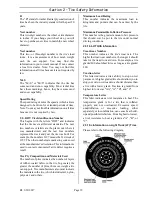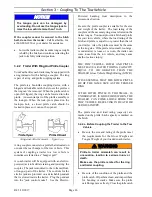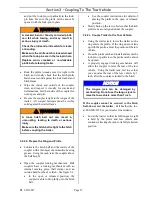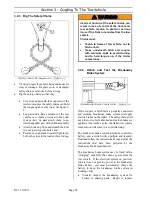
Section 2 – Tire Safety Information
R4 3/30/2017
Page 18
If you have been driving your vehicle and think that
a tire is underinflated, fill it to the recommended
cold inflation pressure indicated on your vehicle's
tire information placard or certification label. While
your tire may still be slightly underinflated due to
the extra pounds of pressure in the warm tire, it is
safer to drive with air pressure that is slightly lower
than the vehicle manufacturer's recommended cold
inflation pressure than to drive with a significantly
underinflated tire. Since this is a temporary fix,
don't forget to recheck and adjust the tire's pressure
when you can obtain a cold reading.
2.5.6 Tire Size
To maintain tire safety, purchase new tires that are
the same size as the vehicle's original tires or
another size recommended by the manufacturer.
Look at the tire information placard, the owner's
manual, or the sidewall of the tire you are replacing
to find this information. If you have any doubt
about the correct size to choose, consult with the
tire dealer.
2.5.7 Tire Tread
The tire tread provides the gripping action and
traction that prevent your vehicle from slipping or
sliding, especially when the road is wet or icy. In
general, tires are not safe and should be replaced
when the tread is worn down to 1/16 of an inch.
Tires have built-in treadwear indicators that let you
know when it is time to replace your tires. These
indicators are raised sections spaced intermittently
in the bottom of the tread grooves. When they
appear "even" with the outside of the tread, it is
time to replace your tires. Another method for
checking tread depth is to place a penny in the tread
with Lincoln's head upside down and facing you. If
you can see the top of Lincoln's head, you are ready
for new tires.
2.5.8 Tire Balance and Wheel Alignment
To avoid vibration or shaking of the vehicle when a
tire rotates, the tire must be properly balanced. This
balance is achieved by positioning weights on the
wheel to counterbalance heavy spots on the wheel-
and-tire assembly. A wheel alignment adjusts the
angles of the wheels so that they are positioned
correctly relative to the vehicle's frame. This
adjustment maximizes the life of your tires. These
adjustments require special equipment and should
be performed by a qualified technician.
2.5.9 Tire Repair
The proper repair of a punctured tire requires a plug
for the hole and a patch for the area inside the tire
that surrounds the puncture hole. Punctures through
the tread can be repaired if they are not too large,
but punctures to the sidewall should not be
repaired. Tires must be removed from the rim to be
properly inspected before being plugged and
patched.
2.5.10 Tire Fundamentals
Federal law requires tire manufacturers to place
standardized information on the sidewall of all tires.
This information identifies and describes the
fundamental characteristics of the tire and also
provides a tire identification number for safety
standard certification and in case of a recall.
2.5.10.a Information on Passenger Vehicle Tires
Please refer to the diagram below.
P
The "P" indicates the tire is for passenger vehicles.
Next number
This three-digit number gives the width in
millimeters of the tire from sidewall edge to
sidewall edge. In general, the larger the number, the
wider the tire.
Next number
This two-digit number, known as the aspect ratio,
gives the tire's ratio of height to width. Numbers of
70 or lower indicate a short sidewall for improved
steering response and better overall handling on dry
pavement.
Summary of Contents for COACH TRAILERS
Page 1: ...COACH TRAILERS OWNER S MANUAL...
Page 6: ......
















































